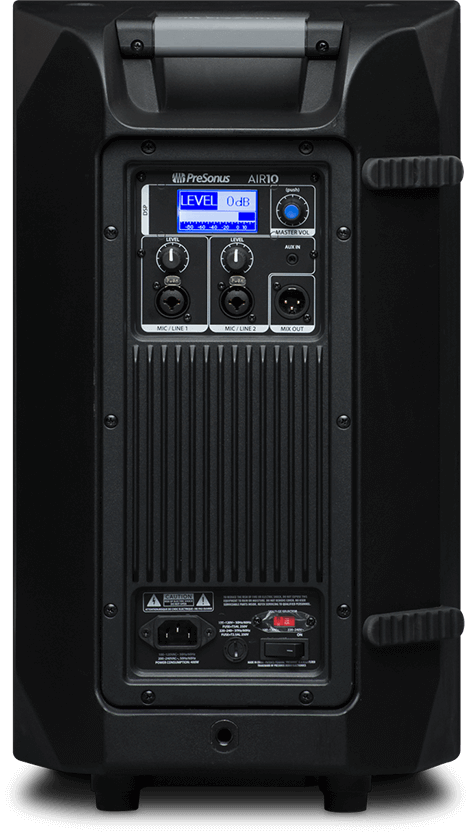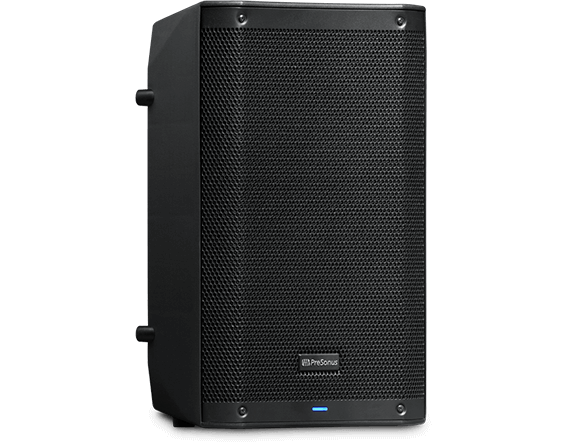We were able to test out the PreSonus AIR10 active PA speakers over the course of a few weeks, and are happy to report that these might just be the hidden gem of the live sound world.
PROS:
lightweight, fantastic audio quality, easy-to-use controls.
CONS:
none.
PRICE:
$499 (each)
Let’s take a closer look at the PreSonus AIR10. For starters, we can tell where the name “AIR” came from; these units are surprisingly light weight for how powerful they are (coming in just under 30 lbs). [editor’s note: in reality, it’s called “AIR” for the “air-y,” clear high-end response, but we like our explanation, too!] From someone who’s done his fair share of load-ins/outs, any chance I can get to lighten the load is a welcome relief.
But of course, my pain-free back means nothing if the speakers are clumsy to use and don’t sound good. Luckily, neither is the case here. In fact, set up is a snap. You’ve got combo XLR/line ins and an aux in on the rear panel for easy hook-ups, and a sweet little screen that’s very well-lit (passing our very scientific “can we adjust this on a dark stage?” test). The on-screen adjustments allow for you to tweak basic EQ settings, of course, but one super handy feature we kept coming back to was the ability to jump between performance presents for different applications. One button push and you can, on-the-fly, go between optimized settings for wedge monitors, front of house, speeches, DJ gigs, etc. Normally we don’t put much stock in presets (because we’re fussy old codgers), but these settings were truly the standout feature. Hey, if it sounds right and saves time at the mixing board, we’re all for it. Traditions be damned.

The ability to just set it for the application you’re using it for, and have it sound right without additional tweaking, might just be the killer app we’ve been waiting for in the PA speaker world (and frankly, we haven’t seen work this well until now).
Tech-wise, you’re looking at max output of 121 dB SPL, and the enclosures feature a two-way system with a 10” low frequency driver and a 1” high frequency driver. And even without a subwoofer, you can get down to about the 55 Hz range, so your bass-thumpin’ DJs will be happy. What’s cool here, as well, is that the AIR10s feature two different types of amplifiers, a 500w (continuous) Class D power amp to fuel the main 10” speaker, and a 200w (continuous) Class A/B for the 1” driver – the reason behind the dual system is to give the best frequency response across the board. So the low-end gets the nice, clean power it needs to operate properly and the highs sound natural and crisp. And the final bonus is that power can be switched over to 50 cycles for our UK friends, as well.

Sound quality, on the whole, is excellent. Highs are crisp, clear and full of headroom and low bass tones from our synthesizers came through cleanly, without the mud we’ve become accustomed to on some other brands. When I hit a low square or triangle wave on my Moog, I want my whole body to feel it. And the AIR10s deliver. Add to that the ultra-rugged enclosures, and we can see these standing up to road abuse year after year. Of course, bands will want to check these out if they’re in charge of their own live sound for non-trad venues (or rehearsal spaces), but the install market will want to put these at the top of their lists, as well. Easy to mount either on poles or with handy flypoints, the AIR10s will likely be an FOH engineer’s new favorite wedges, mains or suspended rig. And just so you know, AIR10 is part of a series that includes the AIR12, AIR15, and two subwoofers: AIR15s and AIR18s.

